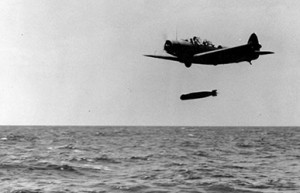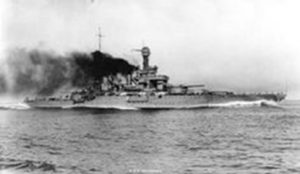Officially, this war lasted from December 1941,

/ ww2db.com
when the United States entered the Second World War, until 1945. But the Pacific War really started with the Sino-Japanese War which began in 1937, when Japan’s concern was to defeat China. This was to be achieved by expanding in South-East Asia, so that Japan could control the raw materials on which she so much depended – oil from Dutch East Indies and Burma (now Myanmar); and tin and rubber from Malaya. She had to cut off China’s supply routes from the south, even if this involved friction with the United States. Moving further south involved risk of conflict with Russia in Manchuria (the Russians came off best after a battle with Japan’s army in 1939 at Nomonhan. Then a non-aggression pact was signed with Russia in April, 1941: thankfully, Adolf Hitler did the double-cross and invaded the Soviet Union in June with his Operation Barbarossa (q.v.)
Japan acquired bases in the north of Indo-China after doing a deal with the pro-Hitler Vichy government (q.v.), and in July demanded bases in the south. This was but a prelude to the attack on Malaya and the Dutch East Indies.
The USA responded well by banning exports of oil and iron to Japan, as also did Holland and Britain. Negotiations were tried between the US and Japan, but failed as the Americans insisted on withdrawal of Japanese forces from China; thus, on December 7, Japanese carrier-borne aircraft attacked the gigantic US base at Pearl Harbor without bothering to declare war (q.v.). At the same time successful attacks were made on British, Dutch and American territories. Guam and Wake Island (US) surrendered. Hong Kong gave up on Christmas Day, and then Singapore, thought to be an unassailable British bastion, fell after the Japanese conquest of Malaya, in February, 1942. The Rising Sun was triumphant almost everywhere.
In the battle of the Java Sea in February 1942 an allied fleet was deprived of four-fifths of its vessels with not a single Japanese loss. Meanwhile in the Indian Ocean the Japanese bombed Ceylon (GB, now Sri Lanka), destroyed a British carrier and two battle cruisers, forcing the Royal Navy to retire rapidly to the Persian Gulf; worse was to come for the Allies; the Japanese overran the Dutch East Indies by March, and British forces withdrew from Burma in May, closing China’s main supply route – the Burma Road. By May it was all over in the Philippines. In less than four months Japan appeared to have won an astonishing victory, acquiring a huge empire due to her forces’ courage, air and sea superiority, plus the undoubted fact that her enemies were uprepared and untrained. Japan had only used eleven divisions, leaving thirteen more waiting in Manchuria, plus twenty-three in China!
But was it all a catastrophe as the West’s newspapers claimed? The Zero fighter-bombers had not quite finished the job at Pearl Harbor (there has not been any carriers when the aeroplanes attacked). The Americans as always began to take back the initiative. The over-confident Japanese tried to extend their defensive perimeter of island bases to include the Solomon Islands and New Guinea. Here, an attempt to take Port Moresby failed in the Battle of the Coral Sea (May 1942), a bizarre sea-battle in which neither side saw or fired at each other. The fight was between carrier-based aircraft in the air, but each side lost a carrier. The Japanese decided not to continue their attack on Port Moresby.
Following this stalemate, the Japanese suffered a serious reverse at the famous Battle of Midway (q.v.), in which they lost four carriers sunk. The American press declared Japanese dominance in the Pacific at an end. Their forces then began the bloody and hard-fought conquest of Japanese-held islands: they began with Guadalcanal in the Solomons in August (not completed until February, 1943).
By dint of extraordinary guts and determination, the Americans achieved air and sea domination in the Pacific, landing where they liked in their island-hopping manoeuvres, ignoring the strongly-defended islands while they took the weaker ones. In the Central Pacific Admiral Nimitz (q.v.) moved from the Gilberts to the Marshals (January 1944) and the Palau Islands (June), while the fabled General Macarthur moved into the Bismarck Archipelago (also January 1944) and continued along the New Guinea coast. But it was not all plain sailing: twice the Japanese challenged American sea supremacy, first in the Battle of the Philippine Sea, where they failed to prevent American capture of Saipan in the Marianas. From here American bombers could reach the main parts of Japan. The second Japanese challenge was at the Battle of Leyte Gulf (q.v.) when the forces of Macarthur and Nimitz were combined to re-take the Philippines. This battle, little written about, still crippled the Japanese Navy and permitted the Americans to get nearer to Japan herself, after the conquest of Iwo Jima in February 1945 and Okinawa, June 1945. The rest of the story of the Pacific War has been well-covered in many General-History articles.











Leave A Comment